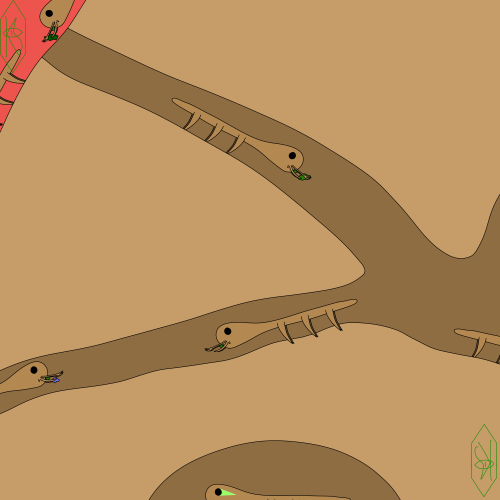A Group Of The Diurnal Skeletons Of The Maschoran Forests






a group of the diurnal skeletons of the maschoran forests
-
 beeb-oob liked this · 1 year ago
beeb-oob liked this · 1 year ago
More Posts from Speculative-world

fortipelta, more commonly called a flightless uking, are moderately sized hardy ostoexoapo, these generalists riddle the maschoran desert and are found even in adjacent areas, due to their hardiness they have become quite the pest in ◗ta settlements, they use their vestigial wings as a form of threat and sexual display, they are the only known ostoexoapo on maschora to perform ovoviviparity holding their eggs in till they hatch and then birthing a large clutch of hatched fortipelta, they usually “lay” their young inside a plant or corpse so they have a large supply of food and resistance to the oppressive heat and dryness of their environment until they mature, they have become a common food item on many colonies in the ◗ta empire due to their ability to thrive in almost any environment, if you have any questions about this seelenlos please dont be afraid to ask i am more than happy to answer

oviodont, more commonly called a colony destroyer, are thin durable ostoexoapo which will invade brachiodontostoma nests once they mate and inject many brachiodontostoma with eggs using their ovipositor, their in the same clade as other flat ostoexoapo however their shell has become compressed to make themselves durable, having thinner parts of their shell in a form of invisible segmentation, this makes them flexibly mobile and well protected, if theyre lucky they will find an exit of the colony once they finish their attack, and continue with their lives, they usually will attempt to find the monarch of the colony to incubate their eggs and will seek out the foodstores and eat what they find and then attempt to leave, their eggs take 4 days after laying to hatch and the young will then begin to eat the colony from the inside out and the entire group of oviodont young will be able to desimate an entire colony in a matter of hours, once they all mature they will leave the abandoned colony and find a mate to continue the cycle, if you have any questions about this seelenlos please dont be afraid to ask i am more than willing to answer
Isn't speculative world the name of one of the oldest and most famous spec evo projects?
maybe! all i know is it was one of the only free urls that i could think of, on another note; i couldnt find anything about this project and im a big sucker for spec evo and spec bio, i would love to read/watch it!


ropalomycete, more commonly called a club wart, these solumykitas are small and hardy only sprouting fruiting bodies after quasiseasonal floods, they create a large net of roots underneath the sands of the maschoran desert, which sometimes get disconnected from the rest of the net during windstorms and even dislodged from dunes it exists in, the fruiting body is covered in thousands of tiny holes which release large quantities of spores which will grow into their own subsurface net structure which has a chance of merging with its parent or another club wart, if you have any questions about this solumykitas please dont be afraid to ask im more than overjoyed to answer

brachiodontostoma, more commonly called a mandible ants, are a close relative of xylostomas which have become very close to true eusociality, having a breeding monarch and larger colonies, the monarch is distinguished by a phosphorescent marking next to their eye, they have adapted their foremost forelimb into a set of venomous spurs and their midforelimbs retain the ability to hold and manipulate their environment, once every couple of clutches a group of young brachiodontosoma are forced out of the colony to build a new one somewhere else, these colonies usually start on a very decayed corpse using the bones as structural support till their mound can support itself, if you have any questions about this ostoexoapo please don't be afraid to ask i am more than happy to answer
